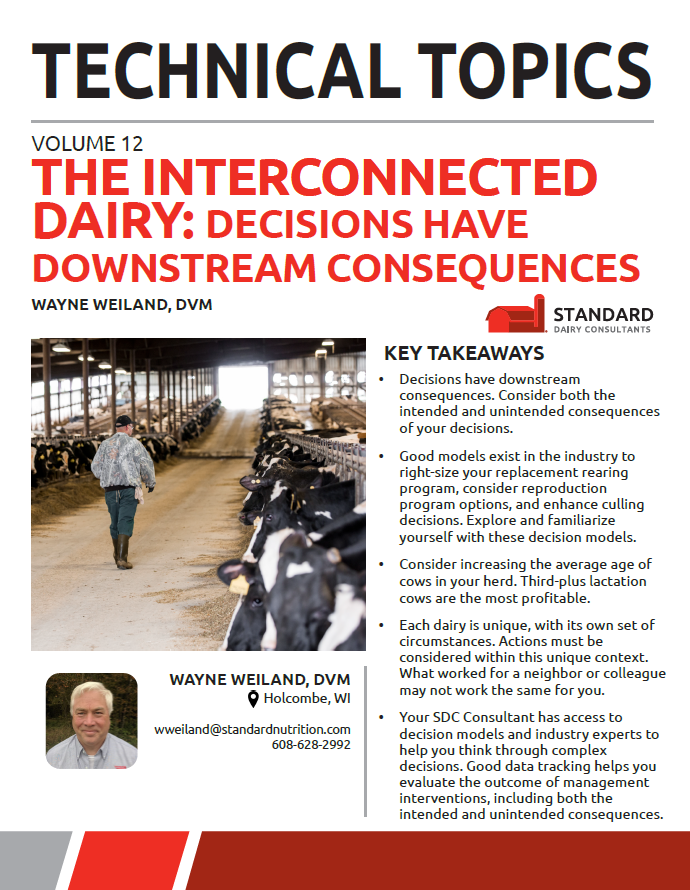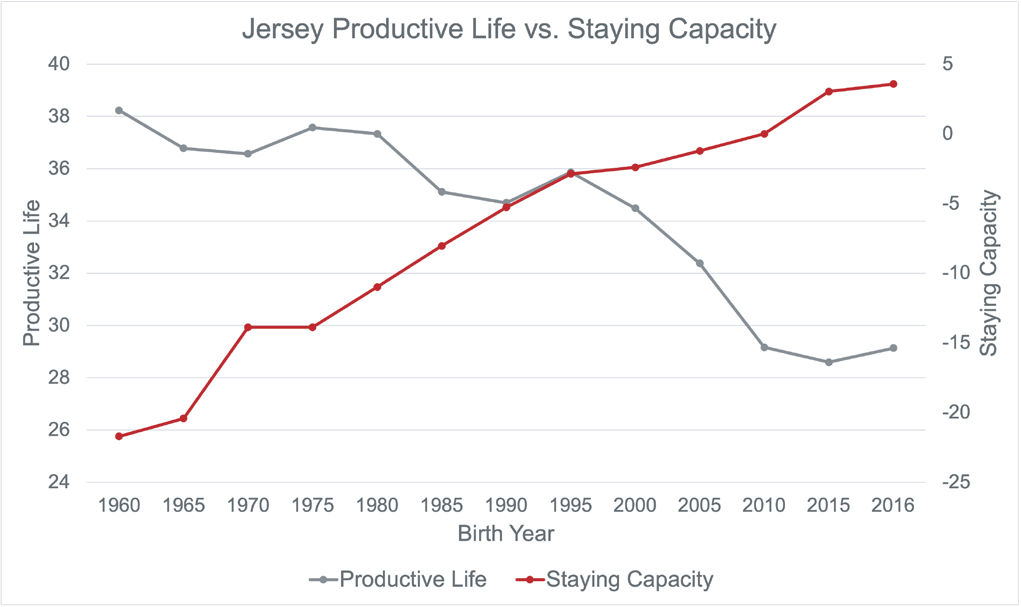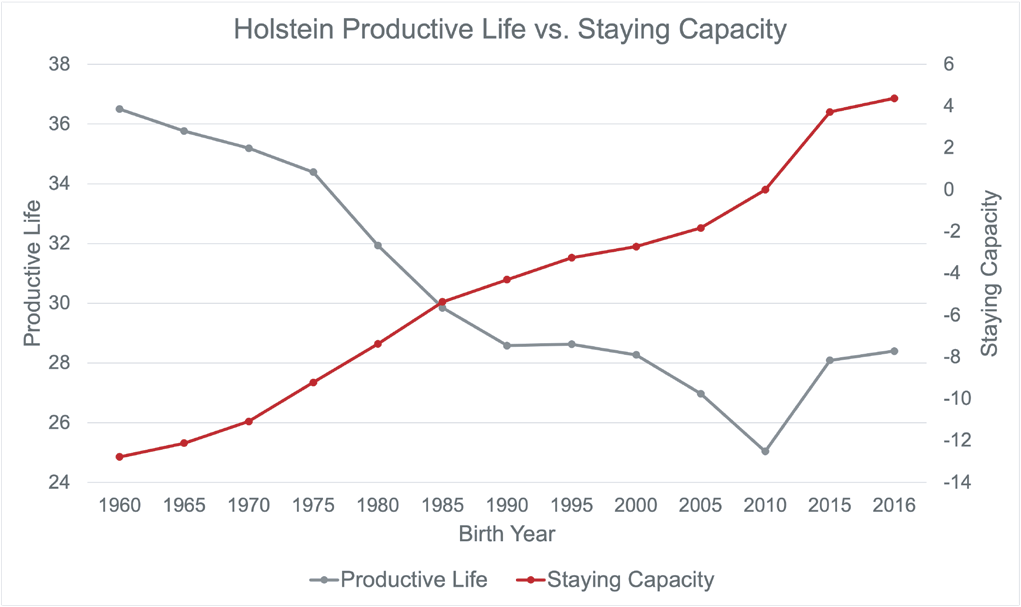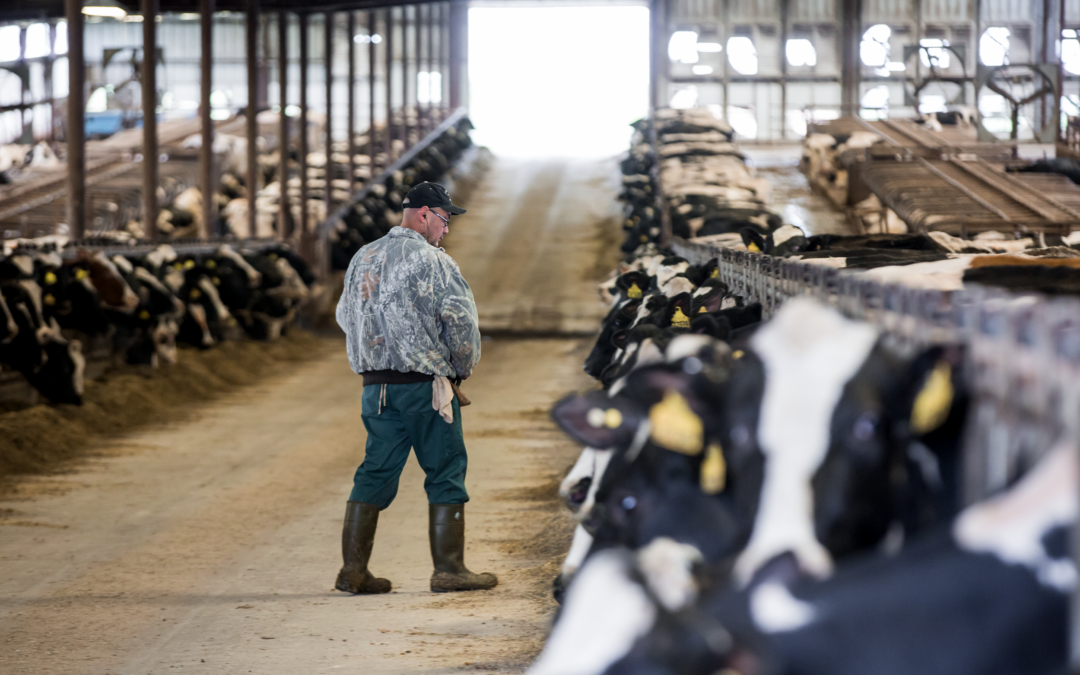Written by: Wayne Weiland
KEY TAKEAWAYS IN THIS ISSUE OF TECHNICAL TOPICS:
- Decisions have downstream consequences. Consider both the intended and unintended consequences of your decisions.
- Good models exist in the industry to right-size your replacement rearing program, consider reproduction program options, and enhance culling decisions. Explore and familiarize yourself with these decision models.
- Consider increasing the average age of cows in your herd. Third-plus lactation cows are the most profitable.
- Each dairy is unique, with its own set of circumstances. Actions must be considered within this unique context. What worked for a neighbor or colleague may not work the same for you.
- Your SDC Consultant has access to decision models and industry experts to help you think through complex decisions. Good data tracking helps you evaluate the outcome of management interventions, including both the intended and unintended consequences.

THE INTERCONNECTED DAIRY
I’ve heard it said over and over that for every action, there is a corresponding reaction. That sure seems to be true in our world today. As systems get more complex, the challenge of anticipating and managing these reactions gets harder. On a similar train of thought, my parents taught me to think through the “unintended consequences” of my actions. A decision or action can initially seem relatively simple. Still, when you think through all of the intended AND unintended consequences of that decision or action, it can get a lot more complicated. So, let’s examine some decisions on a typical dairy that can look relatively simple on the surface, but when considering all of the consequences, might be a little more complex.
As a young veterinarian, I clearly remember a dairy that was losing 50% of its calves before they were weaned. I diligently set out to help them solve this problem. We enhanced the vaccination protocols for dry cows, improved immunity via better management of colostrum and passive transfer, moved calves to hutches, and trained employees to recognize and treat sick calves much earlier. Collectively these actions reduced their calf death loss to less than 5%. A success, right? What I had not considered at the time were the unintended consequences this would have on labor, housing, and feed costs to raise this many more heifers. We significantly increased the replacement rearing cost on this dairy with no immediate return. A year later, the dairy was forced to buy additional feed and employ additional labor. They started having trouble paying the bills. The lender’s focus was on cash flow and subsequently forced this dairy out of business. I got a first-hand look at how unintended consequences can bite you, and it’s a lesson I never forgot.
Dairy owners and managers face this type of situation every day, whether they recognize it or not. As an industry over the past 20 years, we have gotten much better at keeping young stock alive and healthy. More calves are born alive and more survive to enter the lactating herd. There has also been a greater focus on age at calving, specifically bringing that number down from 28 months to 22 to 23 months on many dairies. The enhancements to reproductive efficiency have been nothing short of amazing. I remember when the average Preg Rate was 15% and it’s now in the mid-20s. Then, sexed semen came along and suddenly the market was loaded with replacement heifers (at a value often lower than the cost to raise them). In response, herd culling rates went UP and the average age in the herd went DOWN. What seemed like positive management changes and the adoption of sound technology were having significant unintended consequences.
HOW HAVE DAIRIES ADAPTED?
- Many found themselves raising more replacements than needed at a higher cost than a heifer could be purchased on the open market. There needed to be an effort to “rightsize” the replacement rearing program. The days of raising all of your heifer calves to provide your replacement needs down the road should be over. If you find yourself in that position, you might want to evaluate why your replacement needs are so high and fix the underlying problem. Models are available to the industry that consider pregnancy loss, still-born rates (DOA), calf death losses, use of sexed or beef semen, age to 1st calving, herd culling rates, and future herd expansion plans to help you right-size your replacement program. You might want to consider setting the number a little higher to allow for the culling of underperforming young stock, before you spend all the money to take them through to calving for a predictable lactation underperformance.
- Beef-on-dairy is a term to describe using beef semen in dairy heifers and cows to create a crossbred calf with more desirable traits for meat. This limits the number of dairy replacements born and replaces them with a higher-value beef calf. It has become clear that we want to pay attention to the genomics of the beef bulls being used to deliver the stature, growth rates, and desired meat characteristics meat processors and consumers want. Again, there are programs offered by semen companies to assist in choosing the right beef genetics based on market demands.
- Genetic evaluations allow a person to take this a step further, and assess which dams you want to produce your dairy replacements. Some dairies break cows into 1) High Genetics – to use advanced reproductive techniques like embryo transfer (ET), embryo splitting, and in vitro fertilization techniques; 2) Above Average Genetics – to use sexed semen; 3) Average & Low Genetics – to use conventional or beef semen, depending on the numbers needed to supply the replacement program. These average and low genetic animals can also serve as recipients of ET programs.
- Many dairies have gained significant control over their culling decisions. The percentage of cows culled because they were broken for some reason (involuntary) has dropped and the percentage of cows where the manager chooses who should leave (voluntary) has risen. But are we making the best culling decisions possible? Again, culling models are available that consider milk production, stage of lactation, age, and health and pregnancy status to put a value on each cow in the herd at any given point in time. These are excellent tools to help us make better culling decisions. They are also very under-utilized tools in most dairies.
- The average age of a cow in the US dairy industry is less than two lactations, so less than four years old. Considering it takes an animal about 1.5 lactations to pay for their own rearing cost, that doesn’t leave much time to create a profit for the dairy. Many industry experts would argue we need to increase the average age of cows in our dairies to optimize our profit opportunities. I would agree with them. While there is an argument that younger animals have a higher genetic potential, we have to challenge that thinking. According to one genetics testing company, data show that up to 25% of the heifers test below the genetic potential of the current milking herd. Herd data also suggests that older cows tend to have fewer health problems. This makes sense, as younger cows with a higher incidence of disease problems tend to weed themselves out of the herd. We need to focus on the profit potential, which favors the 3+ lactation cow. While I’m not aware of models to assist with this specific decision yet, I believe they are being developed. This issue on life expectancy is also a hot button for consumers and an opportunity for the dairy industry to present itself in a much better light.
As a dairy producer, you understand well the decisions you make today will have many downstream consequences. It is worth your time to consider both the intended and unintended consequences of those decisions. This task will only get more difficult in the future, as new management practices and products become available. Each dairy has its own set of circumstances, which make it unique and different. Just doing what the neighbor did and had success with could be a very bad decision for you. Your SDC Consultant has access to tools and industry experts to help guide your decision-making process in these areas. They can also assist in monitoring the outcome of any management intervention to help you know what effect the change had and consider what ongoing adjustments might be needed.
WHY DO COWS LEAVE THE MILKING HERD EARLIER THAN IN THE PAST?
Written by: Wayne Weiland, DVM
In 2018, U.S. Holstein cows in the Dairy Herd Improvement (DHI) program remained in the milking herd for an average of 28.4 months. Looking back to those born in 1975, they stayed an average of 34.4 months – a full 6 months longer. The data for Jerseys over the same time period showed 29.1 months in 2018 versus 37.6 months for those born in 1975, for a difference of about 8.5 months. Productive Life (PL) is defined as the interval from the day of first calving (as a 1st lactation animal) to the day the cow left the herd. The Breeding Value (BV) in the chart represents the genetic potential of that animal for staying in the herd. The historic trend line is for a shorter productive live (PL) and an increase in the breeding value (BV) for staying in the herd. Said another way, the average age of cows in the herd is decreasing while their genetic ability to stay in the herd (with the same culling factors over time) is increasing. One has to wonder WHY.
Some might claim today’s high-producing cows are under more stress. That argument has been proven wrong by a Penn State study published in 1965. Cow data was analyzed by looking at eleven low to high-production groups by lactation. This study showed that higher production cows stayed in the herd longer and thus had a longer productive life. This makes sense, as producers will keep their better cows over lower-producing herd mates.
The author speculates this trend to lower productive life is determined by the culling practices of each dairy, and those culling practices vary dramatically from one dairy to the next. This explains why some dairies have older cows in the herd than others. For example, is their goal a low turnover rate to sell breeding stock from high genetic cows or is it a high turnover rate to strive for high genetic indexes? Neither approach is right or wrong, they are just different due to the goals of the dairy owner or manager.


The author concludes: “Cows’ actual tenure in the milking herd is shorter than it used to be due to management decisions, but they have the potential to stay significantly longer than they used to because they have been selected directly for longer productive lives and received a selective improvement in a number of other traits that also support longer life (e.g. daughter pregnancy rate)”.
While the productive life and the average age of cows in the herd are DOWN, their genetic potential to stay in the herd has IMPROVED. This offers the industry an opportunity to rethink our culling practices and impact both productive life and the average age in the herd. Doing so will likely IMPROVE herd profitability over time.
This summary is based on an article by Dr. H. Duane Norman for the Council on Dairy Cattle Breeding in November 2019. Dr. Norman is a Research Leader in USDA’s Animal Improvement Programs Laboratory for 24 years.


